25 July 2025
Global Market Outlook
Global Market Outlook
Prelude to the next rally
Short term consolidation, long term bullish. Investor positioning, seasonality and US trade policy uncertainty point to the risk of near-term equity market volatility or consolidation. However, our long-term quant models have turned more bullish. Use pullbacks to add to equities.
USD short squeeze to create opportunities in EMs. The USD is set for a brief rebound amid one-sided investor positioning. We would use such a rebound to add to assets benefitting from a weak USD: a diversified equity allocation with a tilt towards Asia ex-Japan equities and EM local bonds.
Maintain 5-7-year maturity profile in USD bonds. Temporary rebounds in USD bond yields would create opportunities to add to bonds, but managing volatility by avoiding excessively long maturities is key. Gold remains an attractive core holding.
What could end the US equity rally?
What are the macro factors to watch?
What is driving the bullish turn in your long-term quantitative models?
Strategy
Investment strategy and key themes
|
|
||||
|

12m Foundation Overweights:
- Global equities
- Asia ex-Japan equities
- Emerging Market (EM) local currency (LCY) bonds
Opportunistic ideas – Equities
- US major banks, technology*^
- Korea large-cap equities, China non-financial high-dividend state-owned entities (SOEs) and Hang Seng Technology index
- Europe industrials
Sector Overweights:
- US: Financials, technology, communications
- Europe: Financials, technology, communications, industrials
- China: Communication services, technology, cons. discretionary
Opportunistic ideas – Bonds
- Asia local currency bonds
- UK Gilts (FX-unhedged)
- US Treasury Inflation-Protected Securities (TIPS), US short duration High Yield (HY) bonds*
*New idea
^On pullbacks – see page 12
Prelude to the next rally
- Short term consolidation, long term bullish. Investor positioning, seasonality and US trade policy uncertainty point to the risk of near-term equity market volatility or consolidation. However, our long-term quant models have turned more bullish. Use pullbacks to add to equities.
- USD short squeeze to create opportunities in EMs. The USD is set for a brief rebound amid one-sided investor positioning. We would use such a rebound to add to assets benefitting from a weak USD: a diversified equity allocation with a tilt towards Asia ex-Japan equities and EM local bonds.
- Maintain 5-7-year maturity profile in USD bonds. Temporary rebounds in bond yields will create opportunities to add to bonds, but managing volatility by avoiding excessively long maturities is key. Gold remains an attractive core holding.
Are markets being too optimistic?
Equities and other risky assets have done well since we published our H2 25 Outlook. Global stocks have risen 6.4%, with Asia ex-Japan equities (up 8.6%) outperforming US peers (6.5%), and other risky assets such as HY bonds also performing well. The USD has been volatile, while US bond yields and gold have stayed rangebound.
We see several scattered clouds on the horizon. US policymakers have threatened to return to higher tariffs on major markets on 1 August. While more trade deals may be concluded around this date, the key focus is on the nature of agreements with the EU, South Korea and India, especially after the deal with Japan appeared to raise the baseline tariff for allies to 15% from 10% estimated earlier. The next few months also bring us into a seasonally volatile period for global equities (particularly September).
These risks suggest much focus is likely to return to the Fed and key US data in the coming months. Markets are likely to be concerned about the inflationary impact of a return to higher tariffs, though it is encouraging that long-term market inflation expectations remain subdued. We would also keep a close watch on US job market data as a guide to whether the US economy stays on a soft-landing path. Inflation may remain a focus, but we believe any growth slowdown will create room for the Fed to cut rates in September. Then there is the “Trump put” factor, which posits that the US president will ease his hawkish trade stance if markets react negatively.
Fig. 1 US long-term inflation expectations have remained capped, despite risks from trade policy
US 10-year bond yield, USD 5y5y inflation swap rate
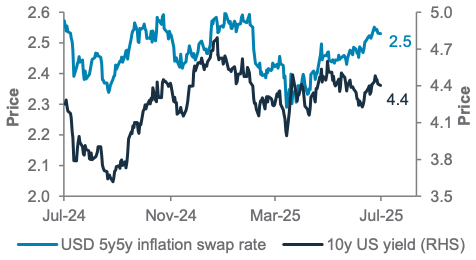
USD to rebound, but only temporarily
As we laid out in our H2 25 Outlook, we expect the potential for narrower rate differentials and uncertain US trade policy to result in a weak USD over the next 6-12 months.
Over the next one-to-three months, though, we do see room for a temporary USD rebound. Positioning and investor survey data show the bearish USD view is increasingly one-sided, an outcome which often results in a countertrend move. This does not change our fundamental weak USD view, but it does mean an opportunity to add to assets that benefit from a weak USD is likely to arise in the next one to three months.
Equities still the first port of call
Equity markets stand at the crossroads of very different short- and long-term signals. While our short-term technical models still favour equities, many key markets look stretched based on our investor positioning signals, as they are hovering around their key resistance. Also, seasonality is becoming less supportive.
US trade policy remains the key event risk over this period. While the conclusion of more deals is likely to reduce concerns, trade policy still risks triggering market volatility in scenarios where (i) deals with key trading partners are not reached by the 1 August deadline, resulting in sharply higher tariffs or (ii) trade deals being concluded, but at higher final tariff levels than expected. Although the US economy has been resilient so far, one knock-on impact of renewed trade uncertainty would be a delay in Fed rate cuts, currently expected to resume from September.
This lukewarm near-term outlook contrasts sharply with the fundamental 6-12-month outlook, where our quantitative models have turned quite bullish. This improvement has been driven by (i) better fundamentals amid earnings beating expectations, (ii) still-constructive valuations in ex-US markets and (iii) strong breadth in equity market participation, with more than 85% of equity markets being above their 200-day moving averages. While we would balance this optimism with ongoing validation via high-frequency growth and earnings data, the bullish signal is clear.
Fig. 2 A short-lived USD rebound would be an opportunity to add to EM equities – we prefer Asia
MSCI EM ex China equities vs global equities, USD index
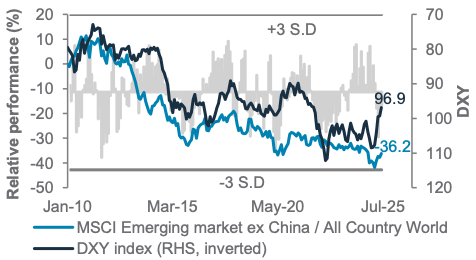
This means that while we expect some volatility over the coming months, we would prepare to take advantage of such volatility to add to our preferred regions. Asia ex-Japan continues to be our most preferred region, with USD rebounds likely to create improved entry points. However, we continue to see core allocations to the US, Euro area and Japan as key components of our view to take advantage of volatility. Within Asia, we remain bullish across major markets, including China, Korea and India, though we maintain a near-term relative preference for North Asian markets.
Add to bonds and gold on dips
We retain our view that the 10-year US government bond yield will return to a 4.00-4.25% range in the coming 6-12 months as the US economy experiences a soft landing. A temporary rise in the yield towards 4.5-4.6% remains possible amid market worries about trade, inflation and the fiscal position. However, we maintain our view that spikes are opportunities to lock in yields.
Recent volatility reinforces our preference for the 5-7-year bond maturity bucket. The recent episodes of upward pressure on US, European and Japanese bond yields was a good reminder that while it is tempting to own very-long-maturity bonds for the yields or exposure to potential price gains, volatility in these bonds can be high. We would also use USD rebounds to add to EM local currency bonds.
We maintain our core allocation to gold. While gold is likely to consolidate for now, we expect continued central bank demand to drive the next leg higher. We also view it as an attractive inflation and weak-USD hedge.
New opportunistic ideas
We would initiate an opportunistic idea to add to the US technology sector on a 5% pullback from the all-time high (see page 12 for levels), consistent with our view that equity pullbacks are likely and are opportunities to add exposure. We also add a short duration US HY bonds idea, viewing this as an attractive way to add to risky assets while taking slightly less risk than longer-maturity HY bonds.
Foundation asset allocation models
The Foundation and Foundation+ models are allocations that you can use as the starting point for building a diversified investment portfolio. The Foundation model showcases a set of allocations focusing on traditional asset classes that are accessible to most investors, while the Foundation+ model includes allocations to private assets that may be accessible to investors in some jurisdictions, but not others.
Fig. 3 Foundation asset allocation for a balanced risk profile

Fig. 4 Foundation+ asset allocation for a balanced risk profile
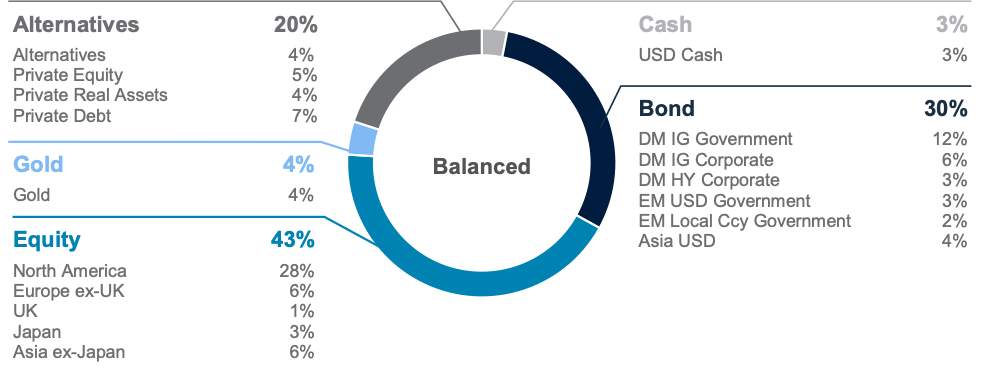
Fig. 5 Multi-asset income allocation for a moderate risk profile

Source: Standard Chartered
Foundation: Our tactical asset allocation views
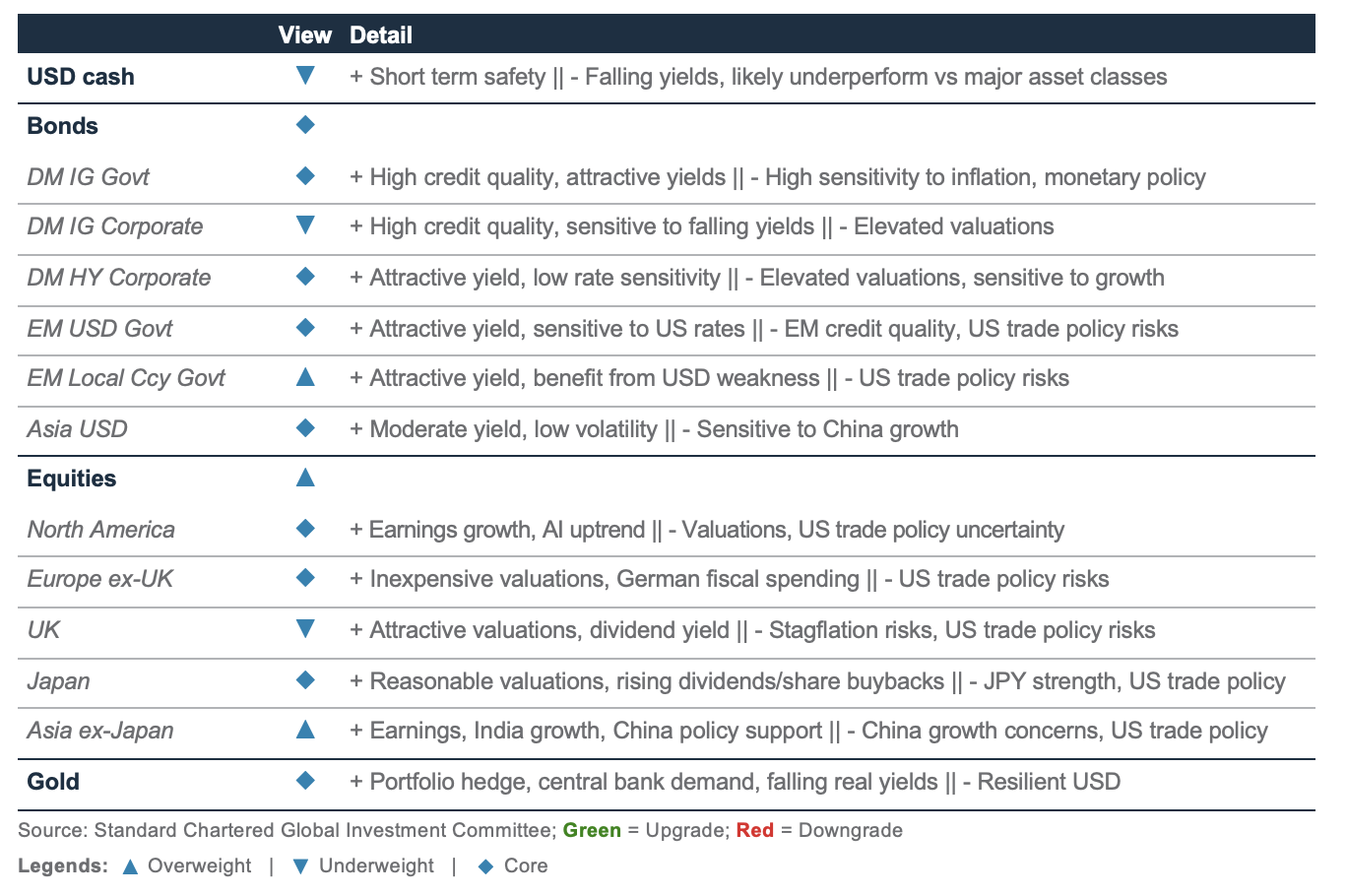
Fig. 6 Performance of our Foundation Allocations*
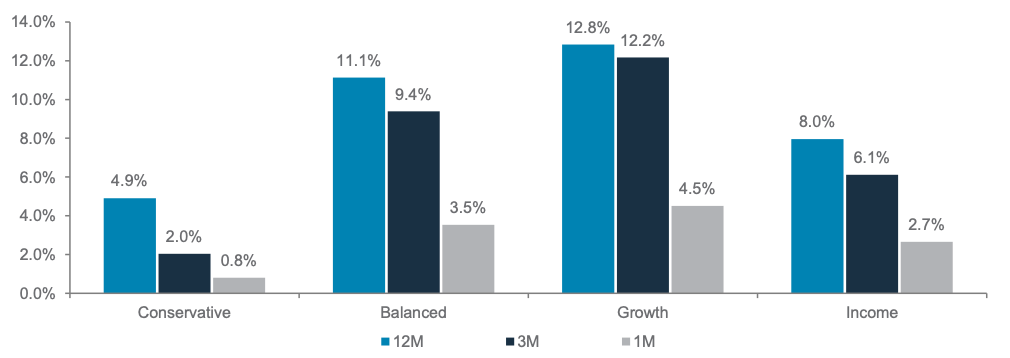
Source: Bloomberg, Standard Chartered; *12-month performance data from 23 July 2024 to 23 July 2025, 3-month performance from 23 April 2025 to 23 July 2025, 1-month performance from 20 June 2025 to 23 July 2025
Perspectives on key client questions
|
|
||||
Bear market signposts: what could end the US equity rally?
- As markets look ahead, the rally faces two critical tests: the credibility of the “Trump put” and the resilience of US fundamentals
- Non-farm payrolls, goods inflation, earnings momentum and correlations among US assets are key signs to watch for whether the US equity rally may be faltering
US equities have surged more than 30% from their April lows, staging not just a powerful rebound from the “Liberation Day” sell-off triggered by President Trump’s tariff threats, but also entering a phase where the rally’s durability is now being tested. At the heart of this recovery are two key drivers:
- Easing tariff risks, as progress on trade talks and Trump’s tendency to backtrack in the face of negative reactions from markets reinforces the view of a “Trump put”.
- Resilient US fundamentals, with the economy and corporate earnings finding support from a weaker USD, bolstering confidence that the US can withstand the impact of tariffs better than its trade partners.
This backdrop of receding US policy uncertainty, resilient fundamentals and a squeeze from previously bearish positioning has propelled the rebound in US equities. However, sustaining the rally hinges on two factors: (i) whether the Trump put remains intact and (ii) whether US resilience holds. Should either falter, downside risks would resurface. We highlight four signposts to watch.
A shift away from “Goldilocks”
Thus far, the US has avoided a tariff-driven slowdown. Q2 GDP is tracking at 2.4% y/y (Atlanta Fed GDPNow), above consensus at 2.1%, while high-frequency activity indicators like the Dallas Fed’s weekly index have rebounded from their May slump. Inflation remains contained, creating a Goldilocks environment of resilient growth and tame inflation – a backdrop historically supportive for equities. Since 1990, the S&P500 has posted positive monthly returns 75% of the time in similar conditions.
Two developments could shift the regime toward recession or stagflation:
- Negative payrolls: While not all recessions start with negative payrolls, but all include them. A succession of negative prints would be a signal of a recession.

Fig. 7 A Goldilocks environment has historically been conducive for equities. Every US recession has been accompanied by negative non-farm payrolls
S&P500 index monthly returns and Goldilocks periods*
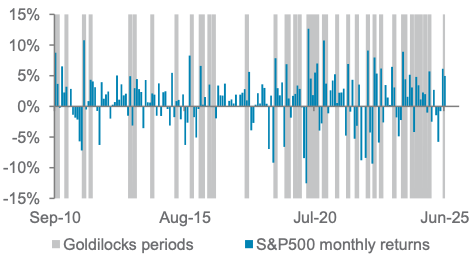
US non-farm payrolls and US recession periods
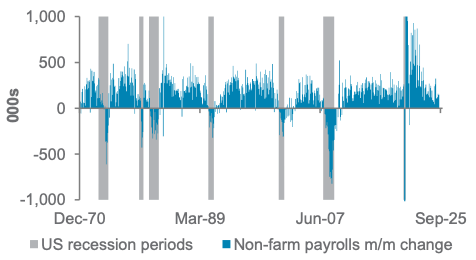
*Goldilocks defined as periods of US cyclicals outperforming defensives and lower US real yields. Source: Bloomberg, Standard Chartered
- Tariff-driven inflation: There are nascent signs of a pick-up in goods inflation in recent inflation readings, though this has been offset by some cooling in service and shelter costs. A broad-based pick-up in goods prices would signal tariffs are indeed feeding into inflation.
A turn in earnings momentum
Corporate earnings have thus far been resilient, sustaining the rally. A weaker USD, improved company guidance and lowered expectations have set the stage for positive earnings surprises. Earnings’ leading indicators and revision indices remain supportive, but with valuations stretched, a loss of momentum could weigh heavily on equities.
Fig. 8 S&P500 earnings leading indicator continues to trend higher, suggesting further upside in US earnings
S&P500 earnings leading indicator, last 12m EPS y/y*
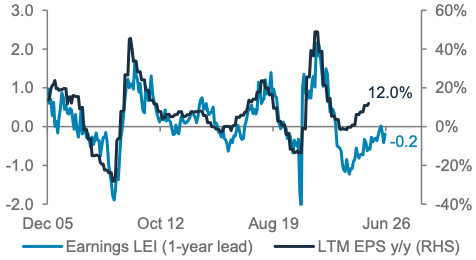
Fig. 9 S&P500 earnings leading indicator continues to trend higher, suggesting further upside in US earnings
S&P500 earnings revision and y/y returns*

Signs of market complacency
Previously, in April, extreme bearish positioning helped fuel the rebound in US equities, but this has since normalised. A renewed surge in bullish positioning would signal complacency and heighten pullback risks. A potential sign of complacency is the growing divergence between the VIX index and US policy uncertainty, which may suggest that markets are under-pricing risks.
Fig. 10 US equity volatility (VIX index) has remained subdued, despite still-elevated US policy uncertainty
US VIX index and US policy uncertainty index
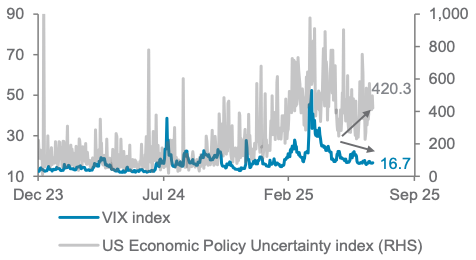
A revival of “US unexceptionalism” fears
An unexpected consequence of April’s tariff shock was the emergence of US unexceptionalism fears, reflected in the rare, correlated declines of the USD, equities and bonds. These fears have since eased, with the USD resuming its typical negative correlation to equities and broadly tracking rate differentials. However, should the USD fall alongside equities or decouple from rate differentials, it would signal the return of those fears, putting renewed pressure on US assets.
Fig. 11 “US exceptionalism” fears have eased
Correlation of USD index (DXY) with S&P500 and US-German (DE) 2-year yield spread
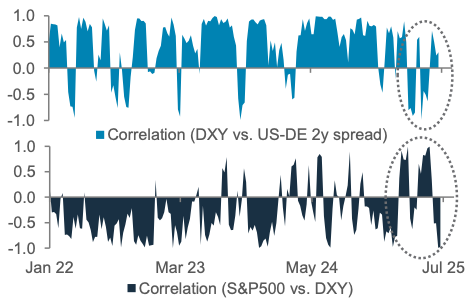
1 August tariff deadline: a litmus test
The rebound in US equities rests on some key foundations: confidence in the “Trump put” and continued resilience of the US economy and corporate earnings. The upcoming tariff deadline on 1 August would test one of these narratives. Should Trump follow through with his tariff threats, a sell-off in US assets would signal the return of US unexceptionalism fears. Conversely, should markets shrug off the threat, it would reinforce the view that the worst-case tariff outcomes can be avoided or that Trump’s “divide-and-conquer” tariff strategy has successfully shifted the burden to trade partners to strike bilateral deals. Either outcome will reveal whether the recovery in US assets can sustain or unravel.
Macro overview – at a glance
Our macroeconomic outlook and key questions
|
Our view
Core scenario (soft landing, 55% probability): The case for a US soft landing got a boost after the Congress passed a mildly stimulative budget. The package, besides extending prior tax cuts, includes new tax cuts/incentives for individuals and domestic manufacturing, which should offset the negative impact of higher import tariffs. Trade deals with key allies are the next focus before higher tariffs kick in on 1 August. A slowing job market means the Fed should resume rate cuts from September, despite a brief revival of goods inflation. Policy easing in China and the Euro area are likely to broaden growth beyond the US.
Downside risk (hard landing, 25% probability): The US economy can be characterised as “low hiring, low firing”. A failure to secure trade deals, leading to higher tariffs, could further hurt corporate margins and consumer confidence, triggering job cuts. Higher US and Japan bond yields due to rising fiscal deficits and/or a USD sell-off are other risks to the soft-landing view.
Upside risk (no landing, 20% probability): The mild US fiscal stimulus and deregulation could help revive private sector “animal spirits”. Meanwhile, US trade deals with allies, a “grand bargain” with China and the Euro area’s (especially Germany’s) fiscal and defence spending boost could revive the world’s three biggest economic blocs, resulting in a more balanced global economy.
Key chart
The US job market has continued to cool as businesses slow the pace of hiring. We expect the Fed to resume rate cuts in September to try and help the economy achieve a soft landing
Fig. 12 Fed rate cuts should resume in September as the US job market slows further
US average weekly hours worked, continuing jobless claims; 12m rate change estimates*

Macro factors to watch
US fiscal impact, deregulation, trade deals: The “One Big Beautiful Bill” is estimated to add USD 3.4trn to the US primary deficit through 2034, according to the Congressional Budget Office. The near-term impact is likely to be higher, as most of the tax cuts and business incentives are front-loaded, while the spending cuts are backloaded. This explains why the bill raised the US borrowing limit by USD 5trn. The new tax breaks for individuals (on top of extension of prior tax cuts), depreciation benefits for domestic manufacturers and planned deregulation of banking, energy and other sectors should support consumption and domestic investment. The risk is that the increased borrowing raises long-term interest rates.
The overall fiscal package should offset the negative impact of import tariffs (a form of tax hike). Based on the latest Japan and other trade deals, we expect the US to reach broad trade agreements which include key allies facing a baseline tariff of 15%, Southeast Asia 20% and extra tariffs on China and select sectors. A revival of tariff-driven goods inflation in H2 is a risk, as it would delay Fed rate cuts.
German fiscal spending to limit ECB rate cuts: Germany finalised a five-year plan to boost infrastructure and defence spending to revive growth. It will lift Germany’s fiscal deficit to an annual average 3.5% of GDP from 2.8% in 2024 and boost annual nominal GDP growth to 3.3% in 2025-2030. Other EU members also plan to lift defence spending. Rising EU fiscal spending is likely to limit further ECB rate cuts, especially if a US trade deal is signed. However, EUR strength is a headwind to growth. We expect one more 25bps ECB deposit rate cut in September, followed by a long pause.
China stimulus to counter trade headwinds: China’s 5.3% y/y H1 growth beat estimates, led by an export boost from front-running US tariffs, a fiscal stimulus front-loading and a consumer trade-in programme. However, China faces the highest US tariffs, despite reaching a truce (thanks to China’s rare earths advantage). Although the worst-case scenario of an all-out trade war has faded, exports are likely to slow in H2. Hence, unlike previous years, we expect Beijing to prioritise the full implementation of its 2025 fiscal budget and modestly ease monetary policy to achieve its c.5% growth target.
Asset Classes
Bonds – at a glance
|
|
||||
|
Our view
Foundation: Global bonds are a core allocation. Interest rate volatility is likely to continue in the near term, with concerns over fiscal deficits, tariffs and mixed economic data. Yield differentials between long- and short-dated bonds are elevated, but have failed to break significantly higher. A slowing job market in H2 25 should open the door for the Fed to cut interest rates in September. As short-term interest rates move lower, we expect the US 10-year government bond yield to move in tandem towards 4.00-4.25% in the next 6-12 months. We view any yield rebounds above 4.50% as attractive opportunities to add exposure to USD bond portfolios. We believe 5-7-year bond maturities offer the best risk-adjusted returns as they strike a balance between attractive yields and fiscal/inflation risks.
New opportunistic idea: US short duration High Yield (HY) bonds offer attractive risk-adjusted returns. Existing opportunistic ideas: Bullish Emerging Market (EM) Asia local currency (LCY) bonds; bullish US Treasury Inflation-Protected Securities (TIPS) and bullish UK government bonds (FX-unhedged).
Key chart
The US 10-year government bond yield can have short term spikes above 4.5%, but we expect the yield to eventually settle towards 4.00-4.25% in the next 6-12 months as growth slows.
Fig. 13 Short duration US HY bonds generated almost a 9% total return in the past year; lower volatility, attractive absolute yield with low default rates are performance drivers
Yield differential of US 10y and 2y government bonds, US 10y government bond yield; total return of short-dated US HY bonds
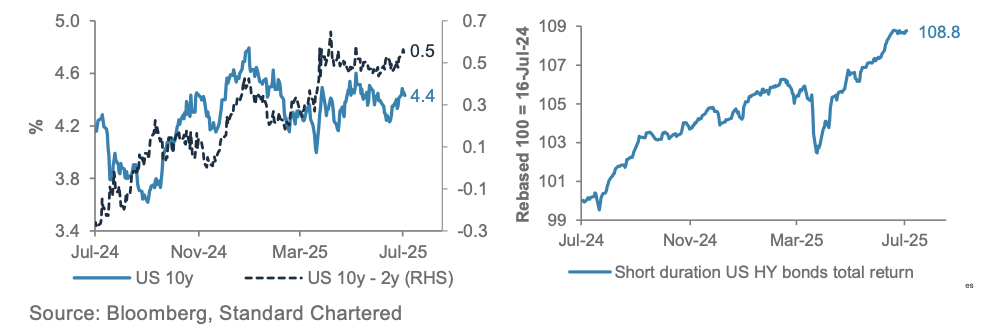
We continue to view global bonds as a core allocation. Within global bonds, we are Overweight EM LCY government bonds, currently yielding around 6%. Benign local inflation and relatively strong fiscal positions are leading to high real (net-of-inflation) yields, while a weak USD provides tailwinds. Moreover, the asset class has a low correlation with DM bonds, providing diversification benefits. This is also the basis for our opportunistic idea on EM Asia LCY bonds (unhedged).
We are Underweight Developed Market (DM) Investment Grade corporate bonds. We expect US government bond yields to drive returns more than yield premiums. The current tight yield premium, among the lows since the Global Financial Crisis, is vulnerable to widening due to uncertainties surrounding US growth. Tight credit spreads are also likely to increase the asset class’s total return volatility generated by interest rate fluctuations.
We initiated a new opportunistic idea on short duration US HY bonds. The attractive absolute yield (currently 7.2%) and low expected default rates (below 2%) are key performance drivers. Short duration bonds have lower price volatility and lower drawdowns than both US HY and US IG corporate bonds and hence offer better risk-adjusted returns.
We maintain the bullish opportunistic idea on TIPS as the risk/reward is still attractive. Tariffs have yet to fully impact inflation, and ongoing fiscal and inflation uncertainty suggest upside risks to longer-term inflation expectations. The latest Yale Budget Lab estimated average US prices from all tariffs imposed this year would rise by 2% in the near term, assuming the Fed does not react to the tariffs. We are also opportunistically bullish on UK government bonds (FX-unhedged) for their nominal yield pick-up vs. other DM government bonds. The UK job market is deteriorating, which may lead to weaker wage growth and disinflationary pressures, allowing the Bank of England to ease interest rates.
Equity – at a glance
|
|
||||
|
|
||||
Our view
We remain Overweight global equities, underpinned by strong earnings, fiscal stimulus in key markets and expectations of a soft landing in the US. Near-term pullbacks on the back of trade or inflation fears would offer opportunities to add exposure.
We expect Asia ex-Japan equities to outperform within global equities, bolstered by the weak USD, which boosts returns for USD-based investors and hence supports fund inflows. China and Korea equities are in focus. Valuations are still attractive; supportive government policies and artificial intelligence innovation are propelling equities higher. India equities remain a core holding, with a shift in preference from large caps to mid-caps, where there is a strong trend in earnings growth.
We retain a core allocation to US equities. A resilient macro backdrop and robust earnings growth in the US are positive factors, counteracting concerns about US’s fiscal sustainability. USD weakness boosts US earnings, but normally undermines US equities relative to non-US markets. We suggest trimming excessive long positioning in US equities.
Key chart
Growth still strong in the US and Asia ex-Japan
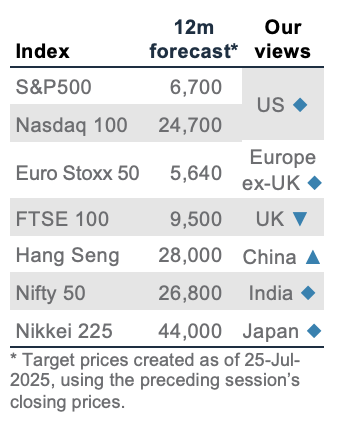
Fig. 14 US’s solid earnings growth underpins strong global equities’ performance. Asia ex-Japan equities’ attractive valuations offer compelling upside potential
Consensus 2025 and 2026 earnings growth estimates for regional MSCI equity indices; Consensus 12m forward price-earnings ratio for Asia ex-Japan vs global equities

Maintaining a regionally diversified allocation
Following the US market rally since Liberation Day, we see an increasing likelihood of a near-term consolidation in the US, as investor positioning has normalised, while there are looming risks ahead of the 1 August deadline before higher US tariffs potentially kick in. The largely resilient Q2 25 earnings and growth projections lend support, but the US equity market is expensive, currently trading at over 2 standard deviations above its historical average. Thus, US equities remain a core holding. We maintain a diversified allocation to non-US stocks.
We retain our Overweight on Asia ex-Japan. A weak USD continues to support the region by boosting returns for USD-based investors and providing a tailwind for fund inflows. We project strong EPS growth of 8.8% in 2025 and 12.7% in 2026, at reasonable valuations. Within the region, we are Overweight Chinese equities. Robust economic figures, including stronger-than-expected Q2 growth,
suggest relatively limited impact from US tariffs. We believe China’s rare earth supply dominance is a key negotiation trump card ahead of the 12 August trade deadline.
We are Overweight South Korea equities within Asia ex-Japan. We see improving shareholder returns under President Lee’s administration. For instance, the passing of the Commercial Act amendment can protect minority shareholders’ interest and support a sustained valuation re-rating. That said, a potential delay of Bank of Korea’s policy pivot may dampen investors’ sentiment near-term.
Indian equities are a Core Holding under Asia ex-Japan. While the RBI extended its expansionary monetary policies, rising concerns on private sector investments may weigh on market confidence, alongside elevated valuations. Within India, we prefer mid-caps, as their superior earnings growth projections more than offset the valuation premium over large caps.
Equity opportunistic views
|
Closing Europe banks, watching US tech
- We take profit on Europe banks with a gain of 10.1% since 27 March 2025, ahead of potential market volatility with ongoing US-EU tariff negotiations.
- We monitor US technology closely. We would initiate on the sector on a 5%* pullback from the recent all-time high. We initiated and closed ideas this year on the broad US technology sector, technology software and US-listed semiconductors. While investor positioning is looking stretched and the earnings season is ongoing, we believe a potential pullback would be an attractive opportunity.
Fig. 15 Opportunistic ideas
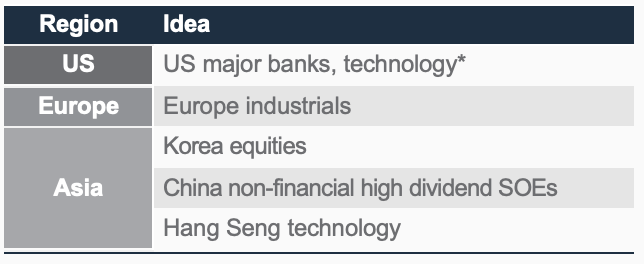
Open bullish ideas
US major banks: They benefit from expected deregulation in the banking sector, which can support earnings growth and greater share buybacks. They also passed their annual stress tests and reported strong Q2 earnings with good guidance. Credit provisions remain well controlled and corporate confidence is improving. Crowded investor positioning and a sharp slowdown in the US economy are risks.
Europe industrials: Europe’s plans to boost infrastructure and defence spending are led by Germany and consistent with NATO plans to raise defence spending from 2% to 5% of GDP. This should support the aerospace and defence, electrical equipment and machinery industries. A sharp slowdown in Europe’s economy is a risk.
Korea equities: President Lee has set up a ‘Kospi 5,000’ committee that aims to improve corporate governance to narrow Korea’s valuation discount. The passage of the commercial code revision showed progress on this front. We expect the return of fund inflows to support ongoing market strength. Weaker-than-expected policy impact is a risk.
China non-financial high-dividend state-owned enterprises (SOEs): Their predominantly domestic exposure means they should benefit from the government’s stimulus
to stabilise growth, such as major infrastructure projects and ongoing consumer subsidies. Non-financial SOEs are less exposed to the troubled property sector. Weaker-than-expected stimulus is a risk.
Hang Seng technology: Policymakers’ support for artificial intelligence (AI) and technology development underpins the growth outlook. Major internet and technology companies are investing heavily in AI, and we expect this to support productivity growth, earnings growth and a valuation re-rating. Valuations remain cheap compared to their US counterparts. Adverse regulatory changes are a risk.
Sector views: Remaining constructive
We remain constructive, with an Overweight on technology in the US, Europe and China, supported by AI investments and software developments. We also remain Overweight on financials (deregulation benefits) and communication services (digital ads and online entertainment growth) in the US. In Europe, we remain Overweight financials on a 6-12 month horizon even as we close our Europe banks opportunistic idea. Financials’ dividend yield and valuation discount to the broader market remain attractive, in our view. In China, we maintain exposure to improving consumption and AI adoption, with our preference for technology, communication and discretionary. Companies in these sectors have strong balance sheets, generate strong cash flows and are investing heavily in AI infrastructure amid strong demand.
Fig. 16 Our sector views by region

FX – at a glance
|
Our view
The USD faces upside risks in the near term, but this would be an opportunity to reduce exposure. The USD index (DXY) appears oversold and may face short-squeeze risk. However, despite US June inflation data accelerating, we expect the Fed to deliver a 25bps rate cut by September. Together with persistent US policy unpredictability, questions over central bank independence and the outlook for weaker US economic growth, we see the USD weakening over a 12-month horizon.
We expect EUR/USD to ease to 1.15 over the next 3 months before recovering to 1.17 in 12 months. A combination of US tariff risks, European political uncertainty – particularly in France – and related economic and fiscal concerns may lead to a choppy EUR performance in the near term. In our base case, we expect the ECB to end its rate cutting cycle in Q3, while the Fed remains on an easing path into 2026. This would suggest that relative US-EU yield differentials, especially in real terms, will support the EUR over a 12-month horizon.
Key chart
We expect the EUR to stay resilient around 1.17 over a 12-month horizon as the yield differential with the US narrows.
Fig. 17 German-US relative yield differentials and EUR/USD; FX forecast table

Clearing the clouds over trade deals
Ongoing US trade negotiations support a near-term USD rebound, but the Fed’s easing cycle continues to weigh on the US currency over a 12-month horizon. Meanwhile, the ECB’s Governing Council members view current interest rates as sufficiently low and see less need for significant additional easing. We expect EUR/USD to test 1.15, then recover to 1.17. We see GBP/USD trading around 1.31 in the near term and rising toward 1.37 over the next 6-12 months.
The latest US-Japan deal could reduce Japanese exports to the US, putting Japan’s growth at risk and delaying BoJ rate hikes. Japan’s political uncertainty and downside pressure on long-term Japanese bonds due to growing fiscal concerns should support near-term upside in USD/JPY towards 150. However, we expect the BoJ to eventually hike rates to counter rising wage-driven inflation pressures. When combined with expected Fed rate cuts, this should drag USD/JPY towards 140 over the next 12 months.
Persistent deflationary pressures in Switzerland are likely to lead the SNB to cut rates further, into negative territory, potentially by September. This is a tailwind for USD/CHF.
Commodity currencies are expected to consolidate. Despite a dovish RBA, we see AUD/USD trading around 0.65, supported by CNH resilience. The RBA surprised markets by holding the cash rate steady at 3.85%, citing a resilient job market, sticky inflation and a pick-up in spending. We also see NZD/USD stabilising around 0.58. New Zealand’s inflation is gaining momentum, which will likely limit the RBNZ’s room for aggressive rate cuts. In Canada, business confidence has improved, but US President Trump’s threats of higher tariffs on Canadian exports may dampen sentiment in the coming months. We expect USD/CAD to stabilise at 1.37 until trade uncertainties are resolved.
Asian currencies stable. We expect USD/CNH to consolidate around 7.2, then edge higher to 7.4 over the next 12 months as China’s economy slows in H2 as the temporary boost from exports, due to the front-running of US import tariffs, fade. Meanwhile, Singapore’s MAS has eased policy in H1, reflecting a shift in focus from inflation to growth. However, upside risk to inflation remains. A policy pause is on the table, giving the MAS flexibility to respond to potential turbulence. As a result, we expect USD/SGD to hover around 1.30 over the next three months.
Gold, crude oil – at a glance
|
|
||||
Our view
Gold is expected to remain rangebound around USD 3,400/oz until US growth risks and trade policy become clearer.
Oversupply remains the dominant theme in oil markets. We expect West Texas Intermediate (WTI) crude oil prices to trade in a range around USD 65/bbl over the next 3-12 months. Geopolitical risks may result in temporary spikes in oil prices.
Key chart
Fig. 18 Investor interest has broadened to other precious metals
Returns of gold priced in USD and other precious metals
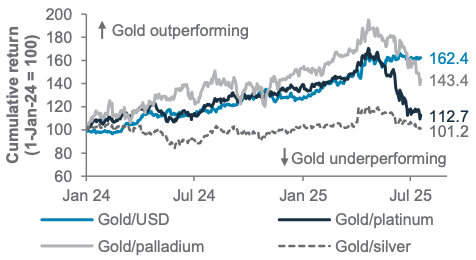
Fig. 20 Tensions in the Middle East could see gold-oil ratio decline
Barrels of oil that 1oz of gold can buy

Fig. 19 Inflows into China gold ETFs stabilised as US-China trade tensions eased
China gold ETFs holdings (tonnes)

Fig. 21 The oil market is likely to remain in surplus this year, keeping prices in check
Oil supply-demand balance, price estimates
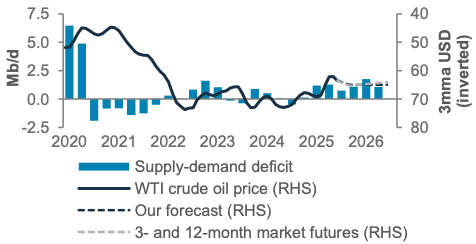
Gold outlook: We expect gold to remain rangebound around USD 3,400/oz in the near-term. For the uptrend in gold to continue, US economic conditions would need to deteriorate further and US tariff risks would need to re-intensify. The upcoming 1 August US tariff deadline could act as a near-term catalyst for gold to retest its all-time high near USD 3,500/oz. However, unless market confidence in the “Trump put” erodes, any upside is likely to be contained. A re-escalation in US-China trade tensions ahead of the 12 August tariff deadline for China could revive gold demand through
Chinese gold exchange-traded funds (ETF). Demand for these ETFs has recently softened. In the meantime, investor interest has broadened to other precious metals.
Oil outlook: Demand-supply outlook continues to argue for an oversupplied oil market. This explains our USD 65/bbl forecast for WTI over 6-12 months. Geopolitics is a clear upside risk – while the extent of excess supply and OPEC+ spare capacity can help offset this, near-term spikes in prices cannot be ruled out. See page 5 for more.
Additional perspectives
Quant perspective
Bullish equities but near-term consolidation likely
|
|
||||
Summary
Add equities on any pullback. Bullish turn in long-term indicators, while short-term positioning is stretched.
Long-term: Our stock-bond model is currently very bullish on equities as fundamentals have improved. In July, the model’s Overweight to equities increased sharply (to a maximum score of 5 from earlier 1). The primary driver of this change was the broad-based improvement in fundamental factors. These included (i) recovery in risk sentiment since April, (ii) a positive economic surprise index, (iii) a rise in the earnings upgrade-versus-downgrade ratio and (iv) an improvement in PMI new orders over the past three months. Our valuation factors are also supportive of equities, as Asian equities still look cheap, while Developed Market equities are not excessively expensive. Current global equity market strength is also supported by strong participation by individual markets.
Our technical framework remains bullish across most equity markets. Despite several markets reaching key resistance in the past month, our technical models have maintained a bullish view following a recovery in market momentum and declining market volatility. These views have turned out well for the S&P500 index and the UK and Asia ex-Japan equity markets since end of June. Our model is Neutral on the MSCI China (USD) index as the market trend was weakening, but the index has managed to bounce from its 100-day moving average amid a de-escalation in trade tensions.
Short-term: Investor positioning is stretched across many risk assets as market sentiment looks overly bullish. In early July, our market diversity indicator flagged stretched investor positioning across many risk assets. This indicates a higher probability of a near-term consolidation. European equities and global High Yield corporate bonds have consolidated intra-month. Assets that are still being flagged are equity benchmarks for the US, UK and Asia ex-Japan and several US, Europe and China equity sectors (please refer to investor positioning signals under short-term models in Figure 24).
Key chart
Our stock-bond model score rose to a maximum of 5 from 1 due to broad-based improvement in fundamental factors.
Fig. 22 Breakdown of our stock-bond rotation model’s scores since inception in Feb-23
Model scores are based on the total of fundamental, valuation and market breadth factors

Our technical model upgraded the S&P500 index to bullish in early May, with the closest resistance now at 6,449 and the closest support at 6,057.
Fig. 23 Our technical model turned bullish on the S&P500 index in early May
S&P500 index; downtrend and bullish-bias regimes; technical support and resistance levels

Fig. 24 Long- and short-term quantitative models are bullish risky assets
Long-term models below have a typical time horizon of 3-6 months, while short-term models have a 1-3-month horizon
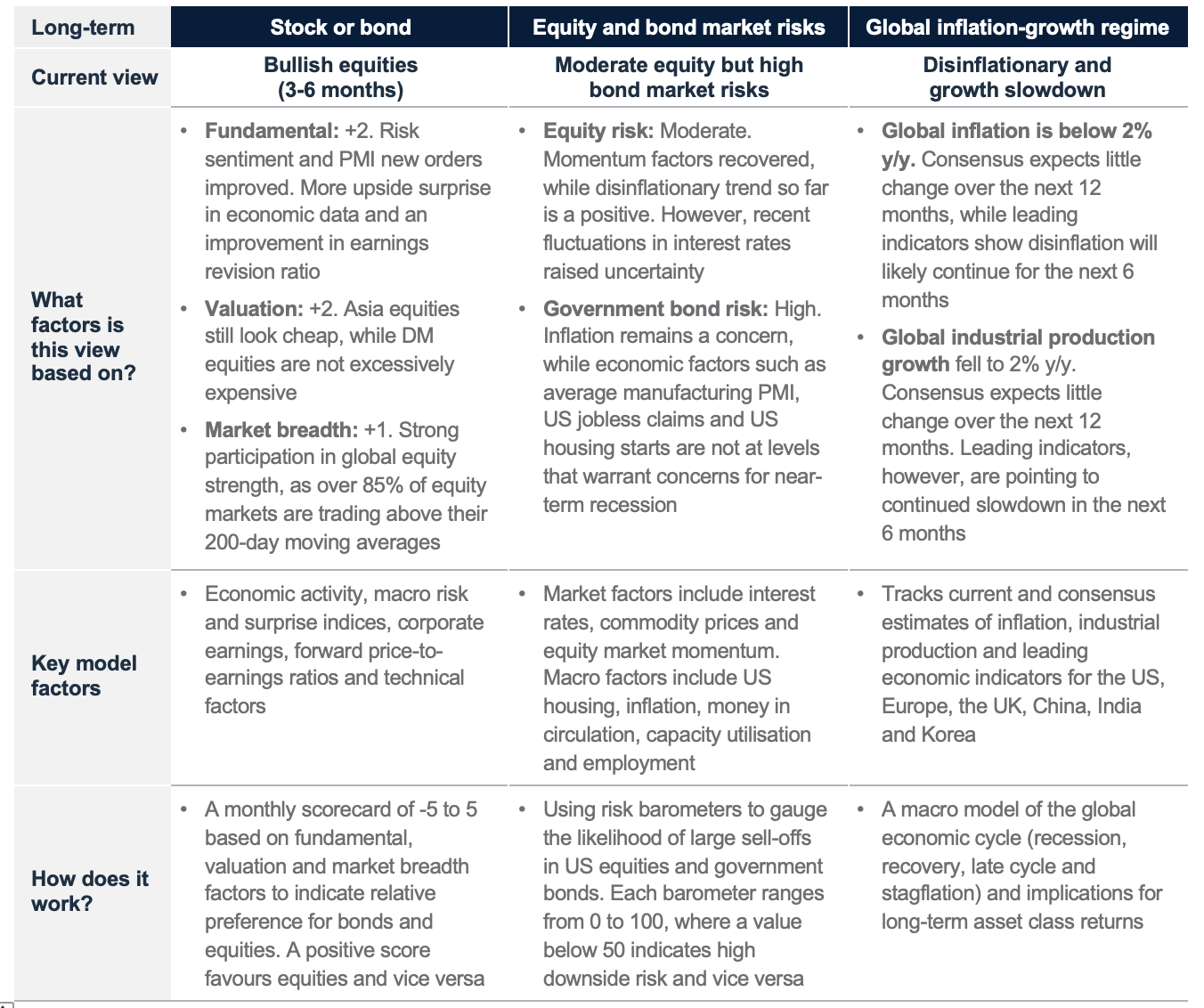
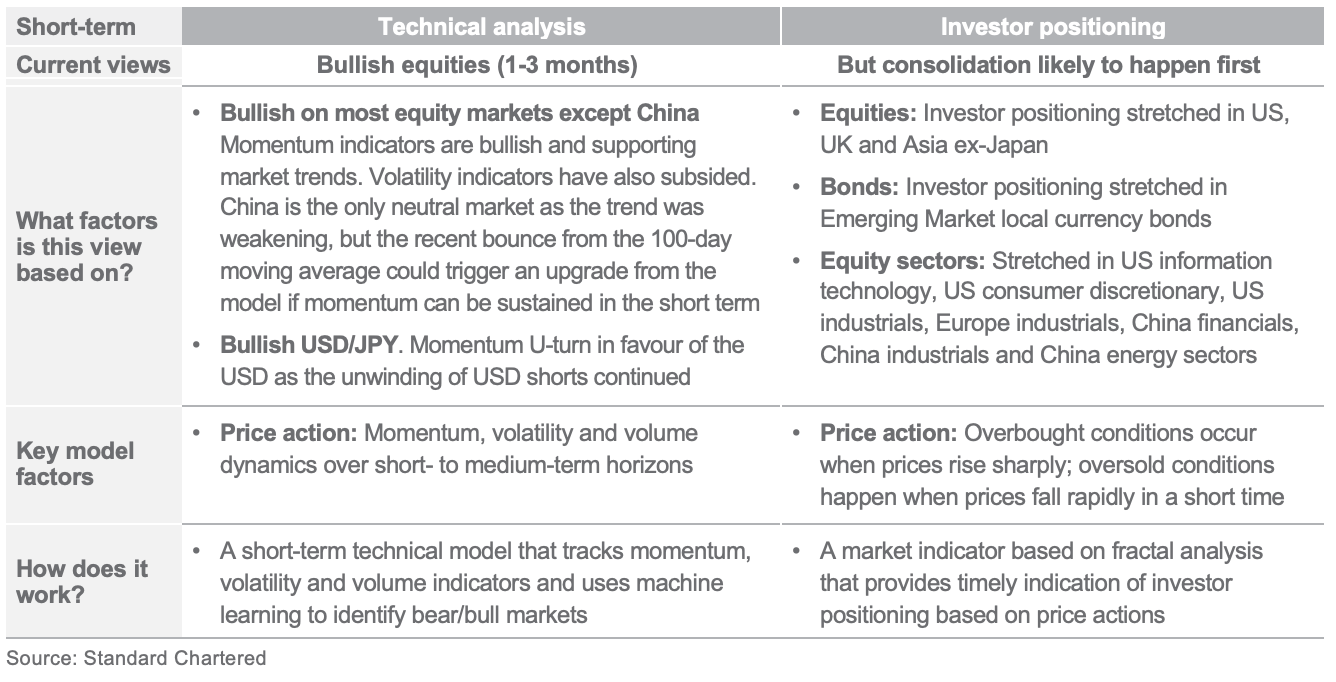
Performance review
Foundation: Asset allocation summary
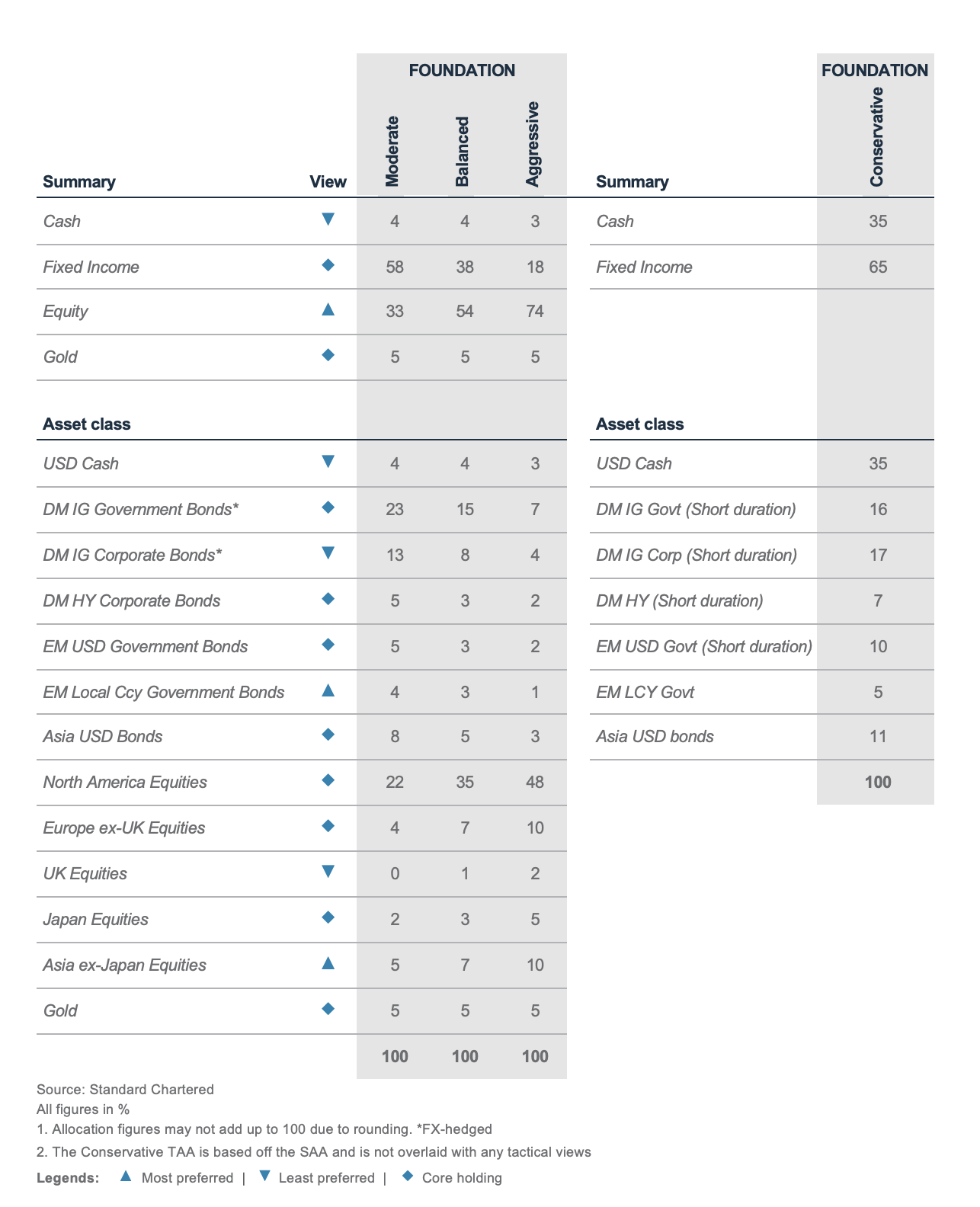
Foundation+: Asset allocation summary
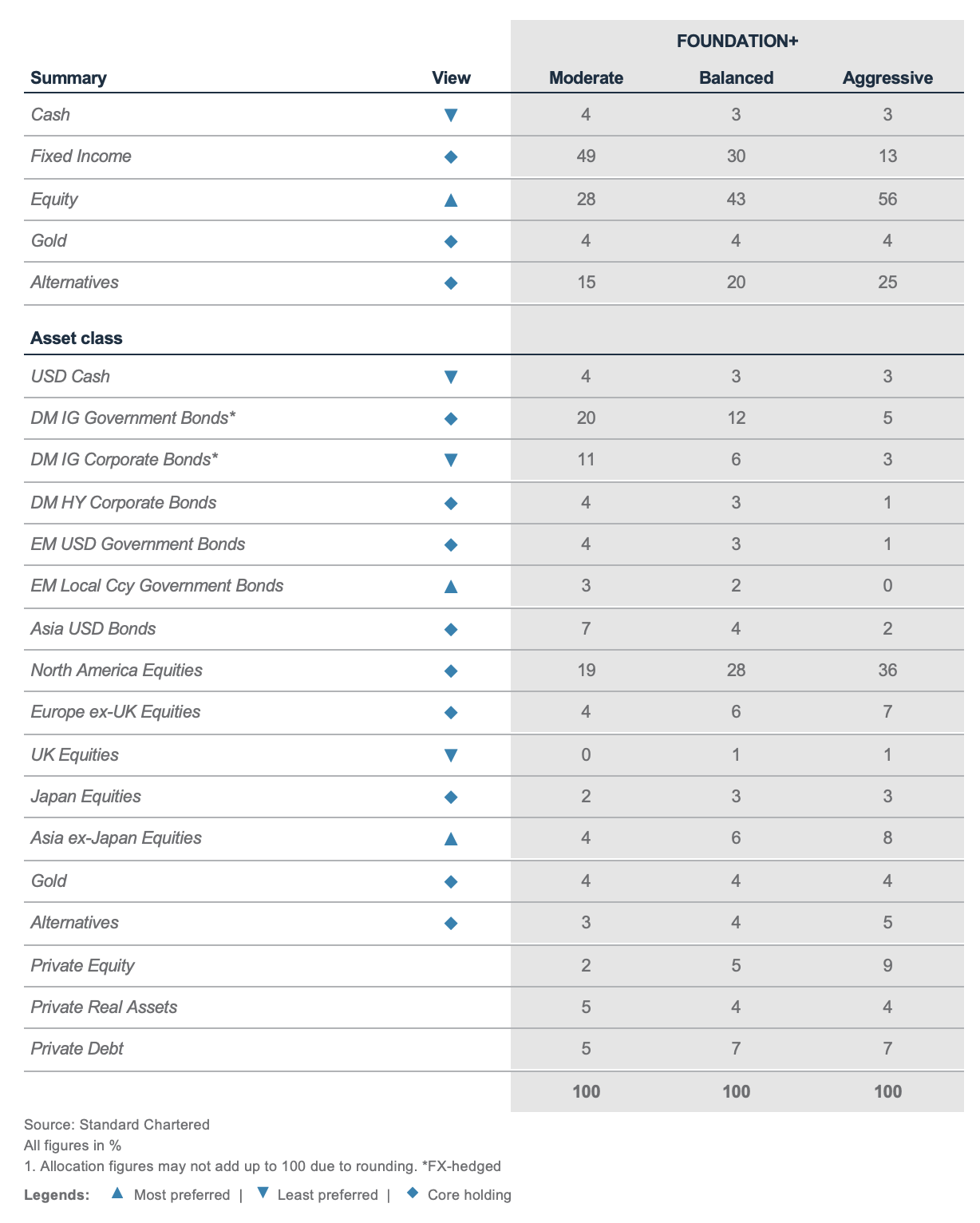

Market performance summary
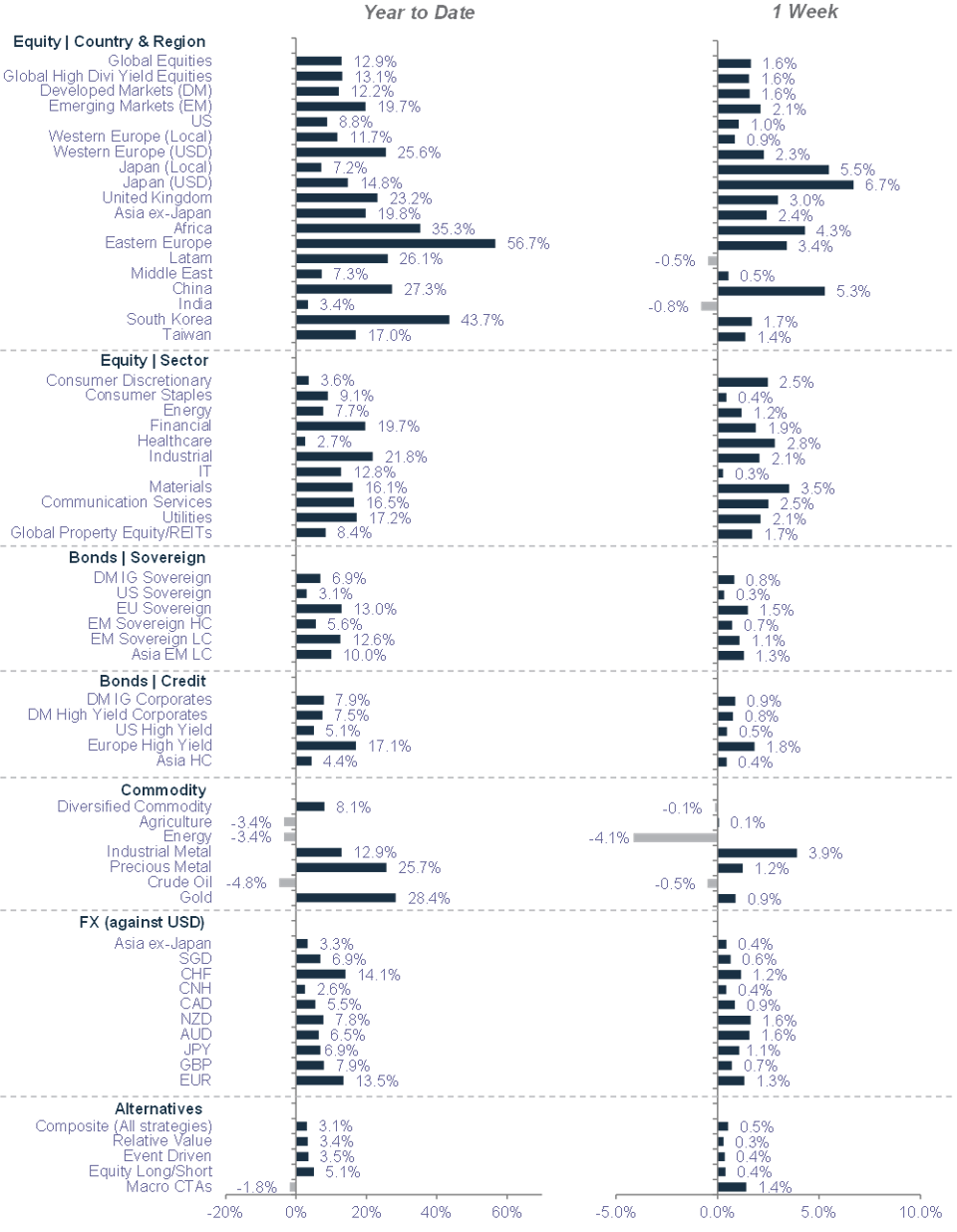
Source: MSCI, JPMorgan, Citigroup, Dow Jones, HFRX, FTSE, Bloomberg, Standard Chartered
*All performance shown in USD terms, unless otherwise stated
*YTD performance data from 31 December 2024 to 24 July 2025; 1-week performance from 17 July 2025 to 24 July 2025
Our key forecasts and calendar events

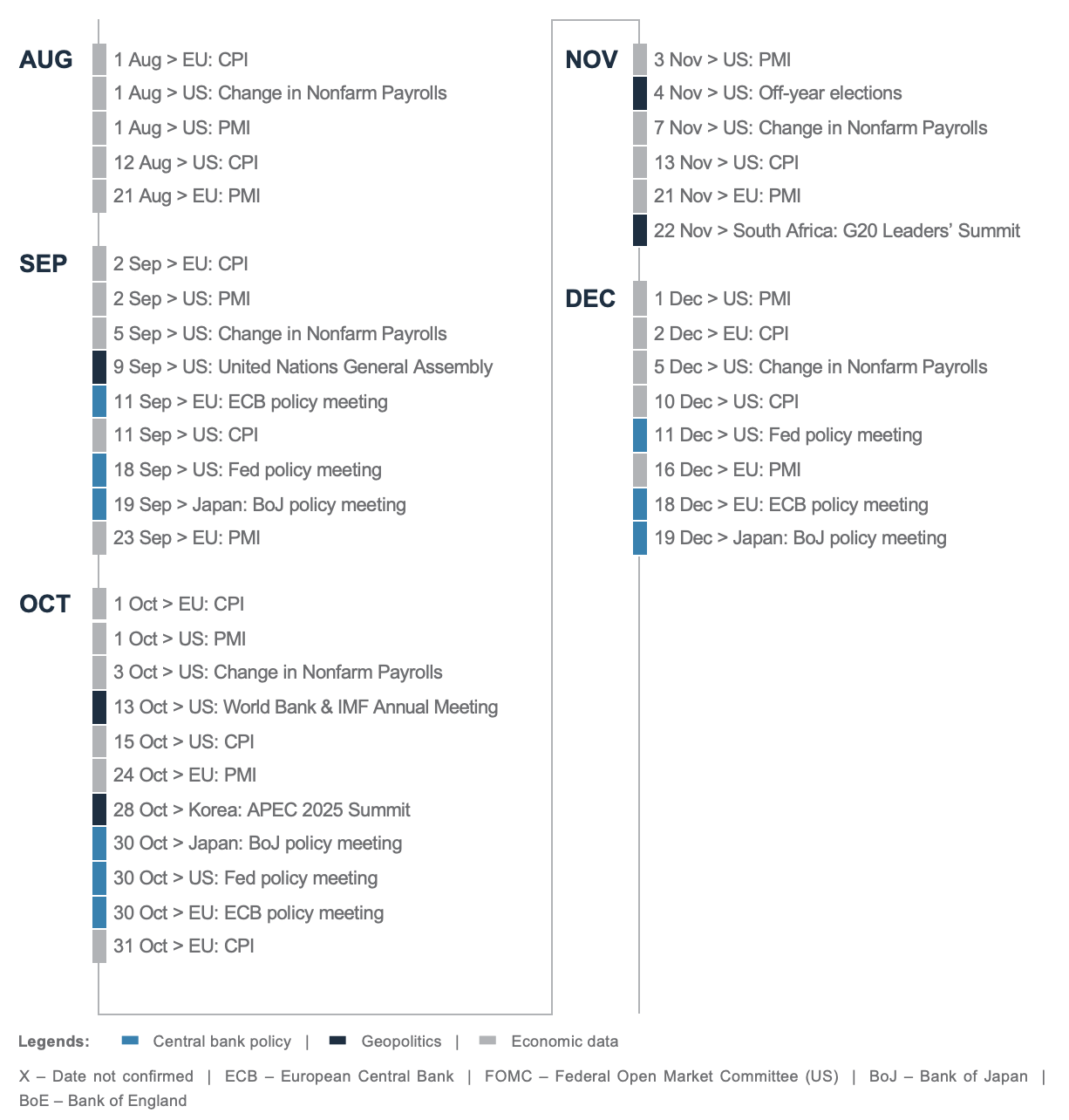
Today, Tomorrow and Forever

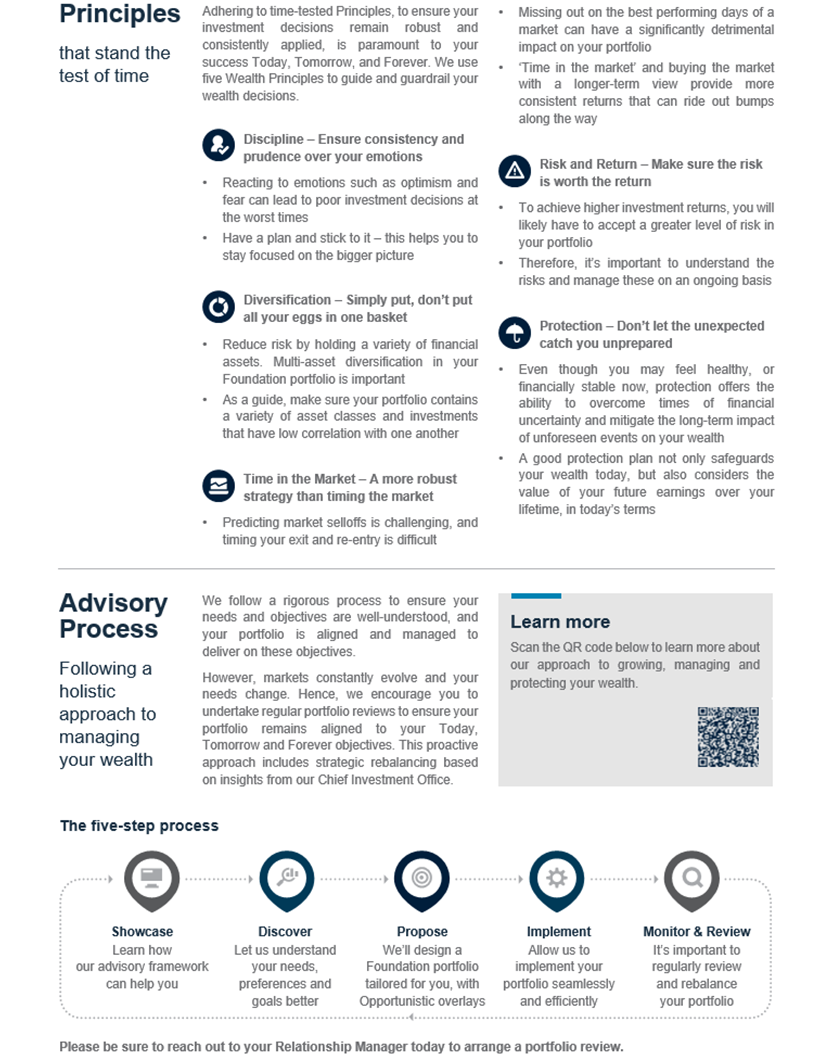

Explanatory notes
1. The figures on page 5 show allocations for a moderately aggressive risk profile only – different risk profiles may produce significantly different asset allocation results. Page 5 is only an example, provided for general information only and they do not constitute investment advice, an offer, recommendation or solicitation. They do not take into account the specific investment objectives, needs or risk tolerances of a particular person or class of persons and they have not been prepared for any particular person or class of persons.
2. Contingent Convertibles are complex financial instruments and are not a suitable or appropriate investment for all investors. This document is not an offer to sell or an invitation to buy any securities or any beneficial interests therein. Contingent convertible securities are not intended to be sold and should not be sold to retail clients in the European Economic Area (EEA) (each as defined in the Policy Statement on the Restrictions on the Retail Distribution of Regulatory Capital Instruments (Feedback to CP14/23 and Final Rules) (“Policy Statement”), read together with the Product Intervention (Contingent Convertible Instruments and Mutual Society Shares) Instrument 2015 (“Instrument”, and together with the Policy Statement, the “Permanent Marketing Restrictions”), which were published by the United Kingdom’s Financial Conduct Authority in June 2015), other than in circumstances that do not give rise to a contravention of the Permanent Marketing Restrictions.
Disclosure
This document is confidential and may also be privileged. If you are not the intended recipient, please destroy all copies and notify the sender immediately. This document is being distributed for general information only and is subject to the relevant disclaimers available at our Standard Chartered website under Regulatory disclosures. It is not and does not constitute research material, independent research, an offer, recommendation or solicitation to enter into any transaction or adopt any hedging, trading or investment strategy, in relation to any securities or other financial instruments. This document is for general evaluation only. It does not take into account the specific investment objectives, financial situation or particular needs of any particular person or class of persons and it has not been prepared for any particular person or class of persons. You should not rely on any contents of this document in making any investment decisions. Before making any investment, you should carefully read the relevant offering documents and seek independent legal, tax and regulatory advice. In particular, we recommend you to seek advice regarding the suitability of the investment product, taking into account your specific investment objectives, financial situation or particular needs, before you make a commitment to purchase the investment product. Opinions, projections and estimates are solely those of SC at the date of this document and subject to change without notice. Past performance is not indicative of future results and no representation or warranty is made regarding future performance. The value of investments, and the income from them, can go down as well as up, and you may not recover the amount of your original investment. You are not certain to make a profit and may lose money. Any forecast contained herein as to likely future movements in rates or prices or likely future events or occurrences constitutes an opinion only and is not indicative of actual future movements in rates or prices or actual future events or occurrences (as the case may be). This document must not be forwarded or otherwise made available to any other person without the express written consent of the Standard Chartered Group (as defined below). Standard Chartered Bank is incorporated in England with limited liability by Royal Charter 1853 Reference Number ZC18. The Principal Office of the Company is situated in England at 1 Basinghall Avenue, London, EC2V 5DD. Standard Chartered Bank is authorised by the Prudential Regulation Authority and regulated by the Financial Conduct Authority and Prudential Regulation Authority. Standard Chartered PLC, the ultimate parent company of Standard Chartered Bank, together with its subsidiaries and affiliates (including each branch or representative office), form the Standard Chartered Group. Standard Chartered Private Bank is the private banking division of Standard Chartered. Private banking activities may be carried out internationally by different legal entities and affiliates within the Standard Chartered Group (each an “SC Group Entity”) according to local regulatory requirements. Not all products and services are provided by all branches, subsidiaries and affiliates within the Standard Chartered Group. Some of the SC Group Entities only act as representatives of Standard Chartered Private Bank and may not be able to offer products and services or offer advice to clients.
Copyright © 2025, Accounting Research & Analytics, LLC d/b/a CFRA (and its affiliates, as applicable). Reproduction of content provided by CFRA in any form is prohibited except with the prior written permission of CFRA. CFRA content is not investment advice and a reference to or observation concerning a security or investment provided in the CFRA SERVICES is not a recommendation to buy, sell or hold such investment or security or make any other investment decisions. The CFRA content contains opinions of CFRA based upon publicly-available information that CFRA believes to be reliable and the opinions are subject to change without notice. This analysis has not been submitted to, nor received approval from, the United States Securities and Exchange Commission or any other regulatory body. While CFRA exercised due care in compiling this analysis, CFRA, ITS THIRD-PARTY SUPPLIERS, AND ALL RELATED ENTITIES SPECIFICALLY DISCLAIM ALL WARRANTIES, EXPRESS OR IMPLIED, INCLUDING, BUT NOT LIMITED TO, ANY WARRANTIES OF MERCHANTABILITY OR FITNESS FOR A PARTICULAR PURPOSE OR USE, to the full extent permitted by law, regarding the accuracy, completeness, or usefulness of this information and assumes no liability with respect to the consequences of relying on this information for investment or other purposes. No content provided by CFRA (including ratings, credit-related analyses and data, valuations, model, software or other application or output therefrom) or any part thereof may be modified, reverse engineered, reproduced or distributed in any form by any means, or stored in a database or retrieval system, without the prior written permission of CFRA, and such content shall not be used for any unlawful or unauthorized purposes. CFRA and any third-party providers, as well as their directors, officers, shareholders, employees or agents do not guarantee the accuracy, completeness, timeliness or availability of such content. In no event shall CFRA, its affiliates, or their third-party suppliers be liable for any direct, indirect, special, or consequential damages, costs, expenses, legal fees, or losses (including lost income or lost profit and opportunity costs) in connection with a subscriber’s, subscriber’s customer’s, or other’s use of CFRA’s content.
Market Abuse Regulation (MAR) Disclaimer
Banking activities may be carried out internationally by different branches, subsidiaries and affiliates within the Standard Chartered Group according to local regulatory requirements. Opinions may contain outright “buy”, “sell”, “hold” or other opinions. The time horizon of this opinion is dependent on prevailing market conditions and there is no planned frequency for updates to the opinion. This opinion is not independent of Standard Chartered Group’s trading strategies or positions. Standard Chartered Group and/or its affiliates or its respective officers, directors, employee benefit programmes or employees, including persons involved in the preparation or issuance of this document may at any time, to the extent permitted by applicable law and/or regulation, be long or short any securities or financial instruments referred to in this document or have material interest in any such securities or related investments. Therefore, it is possible, and you should assume, that Standard Chartered Group has a material interest in one or more of the financial instruments mentioned herein. Please refer to our Standard Chartered website under Regulatory disclosures for more detailed disclosures, including past opinions/ recommendations in the last 12 months and conflict of interests, as well as disclaimers. A covering strategist may have a financial interest in the debt or equity securities of this company/issuer. All covering strategist are licensed to provide investment recommendations under Monetary Authority of Singapore or Hong Kong Monetary Authority. This document must not be forwarded or otherwise made available to any other person without the express written consent of Standard Chartered Group.
Sustainable Investments
Any ESG data used or referred to has been provided by Morningstar, Sustainalytics, MSCI or Bloomberg. Refer to 1) Morningstar website under Sustainable Investing, 2) Sustainalytics website under ESG Risk Ratings, 3) MCSI website under ESG Business Involvement Screening Research and 4) Bloomberg green, social & sustainability bonds guide for more information. The ESG data is as at the date of publication based on data provided, is for informational purpose only and is not warranted to be complete, timely, accurate or suitable for a particular purpose, and it may be subject to change. Sustainable Investments (SI): This refers to funds that have been classified as ‘Sustainable Investments’ by Morningstar. SI funds have explicitly stated in their prospectus and regulatory filings that they either incorporate ESG factors into the investment process or have a thematic focus on the environment, gender diversity, low carbon, renewable energy, water or community development. For equity, it refers to shares/stocks issued by companies with Sustainalytics ESG Risk Rating of Low/Negligible. For bonds, it refers to debt instruments issued by issuers with Sustainalytics ESG Risk Rating of Low/Negligible, and/or those being certified green, social, sustainable bonds by Bloomberg. For structured products, it refers to products that are issued by any issuer who has a Sustainable Finance framework that aligns with Standard Chartered’s Green and Sustainable Product Framework, with underlying assets that are part of the Sustainable Investment universe or separately approved by Standard Chartered’s Sustainable Finance Governance Committee. Sustainalytics ESG risk ratings shown are factual and are not an indicator that the product is classified or marketed as “green”, “sustainable” or similar under any particular classification system or framework.
Country/Market Specific Disclosures
Botswana: This document is being distributed in Botswana by, and is attributable to, Standard Chartered Bank Botswana Limited which is a financial institution licensed under the Section 6 of the Banking Act CAP 46.04 and is listed in the Botswana Stock Exchange. Brunei Darussalam: This document is being distributed in Brunei Darussalam by, and is attributable to, Standard Chartered Bank (Brunei Branch) | Registration Number RFC/61 and Standard Chartered Securities (B) Sdn Bhd | Registration Number RC20001003. Standard Chartered Bank is incorporated in England with limited liability by Royal Charter 1853 Reference Number ZC18. Standard Chartered Securities (B) Sdn Bhd is a limited liability company registered with the Registry of Companies with Registration Number RC20001003 and licensed by Brunei Darussalam Central Bank as a Capital Markets Service License Holder with License Number BDCB/R/CMU/S3-CL and it is authorised to conduct Islamic investment business through an Islamic window. China Mainland: This document is being distributed in China by, and is attributable to, Standard Chartered Bank (China) Limited which is mainly regulated by National Financial Regulatory Administration (NFRA), State Administration of Foreign Exchange (SAFE), and People’s Bank of China (PBOC). Hong Kong: In Hong Kong, this document, except for any portion advising on or facilitating any decision on futures contracts trading, is distributed by Standard Chartered Bank (Hong Kong) Limited (“SCBHK”), a subsidiary of Standard Chartered PLC. SCBHK has its registered address at 32/F, Standard Chartered Bank Building, 4-4A Des Voeux Road Central, Hong Kong and is regulated by the Hong Kong Monetary Authority and registered with the Securities and Futures Commission (“SFC”) to carry on Type 1 (dealing in securities), Type 4 (advising on securities), Type 6 (advising on corporate finance) and Type 9 (asset management) regulated activity under the Securities and Futures Ordinance (Cap. 571) (“SFO”) (CE No. AJI614). The contents of this document have not been reviewed by any regulatory authority in Hong Kong and you are advised to exercise caution in relation to any offer set out herein. If you are in doubt about any of the contents of this document, you should obtain independent professional advice. Any product named herein may not be offered or sold in Hong Kong by means of any document at any time other than to “professional investors” as defined in the SFO and any rules made under that ordinance. In addition, this document may not be issued or possessed for the purposes of issue, whether in Hong Kong or elsewhere, and any interests may not be disposed of, to any person unless such person is outside Hong Kong or is a “professional investor” as defined in the SFO and any rules made under that ordinance, or as otherwise may be permitted by that ordinance. In Hong Kong, Standard Chartered Private Bank is the private banking division of SCBHK, a subsidiary of Standard Chartered PLC. Ghana: Standard Chartered Bank Ghana Limited accepts no liability and will not be liable for any loss or damage arising directly or indirectly (including special, incidental or consequential loss or damage) from your use of these documents. Past performance is not indicative of future results and no representation or warranty is made regarding future performance. You should seek advice from a financial adviser on the suitability of an investment for you, taking into account these factors before making a commitment to invest in an investment. To unsubscribe from receiving further updates, please send an email to feedback.ghana@sc.com. Please do not reply to this email. Call our Priority Banking on 0302610750 for any questions or service queries. You are advised not to send any confidential and/or important information to Standard Chartered via e-mail, as Standard Chartered makes no representations or warranties as to the security or accuracy of any information transmitted via e-mail. Standard Chartered shall not be responsible for any loss or damage suffered by you arising from your decision to use e-mail to communicate with the Bank. India: This document is being distributed in India by Standard Chartered in its capacity as a distributor of mutual funds and referrer of any other third party financial products. Standard Chartered does not offer any ‘Investment Advice’ as defined in the Securities and Exchange Board of India (Investment Advisers) Regulations, 2013 or otherwise. Services/products related securities business offered by Standard Charted are not intended for any person, who is a resident of any jurisdiction, the laws of which imposes prohibition on soliciting the securities business in that jurisdiction without going through the registration requirements and/or prohibit the use of any information contained in this document. Indonesia: This document is being distributed in Indonesia by Standard Chartered Bank, Indonesia branch, which is a financial institution licensed and supervised by Otoritas Jasa Keuangan (Financial Service Authority) and Bank Indonesia. Jersey: In Jersey, Standard Chartered Private Bank is the Registered Business Name of the Jersey Branch of Standard Chartered Bank. The Jersey Branch of Standard Chartered Bank is regulated by the Jersey Financial Services Commission. Copies of the latest audited accounts of Standard Chartered Bank are available from its principal place of business in Jersey: PO Box 80, 15 Castle Street, St Helier, Jersey JE4 8PT. Standard Chartered Bank is incorporated in England with limited liability by Royal Charter in 1853 Reference Number ZC 18. The Principal Office of the Company is situated in England at 1 Basinghall Avenue, London, EC2V 5DD. Standard Chartered Bank is authorised by the Prudential Regulation Authority and regulated by the Financial Conduct Authority and Prudential Regulation Authority. The Jersey Branch of Standard Chartered Bank is also an authorised financial services provider under license number 44946 issued by the Financial Sector Conduct Authority of the Republic of South Africa. Jersey is not part of the United Kingdom and all business transacted with Standard Chartered Bank, Jersey Branch and other SC Group Entity outside of the United Kingdom, are not subject to some or any of the investor protection and compensation schemes available under United Kingdom law. Kenya: This document is being distributed in Kenya by and is attributable to Standard Chartered Bank Kenya Limited. Investment Products and Services are distributed by Standard Chartered Investment Services Limited, a wholly owned subsidiary of Standard Chartered Bank Kenya Limited that is licensed by the Capital Markets Authority in Kenya, as a Fund Manager. Standard Chartered Bank Kenya Limited is regulated by the Central Bank of Kenya. Malaysia: This document is being distributed in Malaysia by Standard Chartered Bank Malaysia Berhad (“SCBMB”). Recipients in Malaysia should contact SCBMB in relation to any matters arising from, or in connection with, this document. This document has not been reviewed by the Securities Commission Malaysia. The product lodgement, registration, submission or approval by the Securities Commission of Malaysia does not amount to nor indicate recommendation or endorsement of the product, service or promotional activity. Investment products are not deposits and are not obligations of, not guaranteed by, and not protected by SCBMB or any of the affiliates or subsidiaries, or by Perbadanan Insurans Deposit Malaysia, any government or insurance agency. Investment products are subject to investment risks, including the possible loss of the principal amount invested. SCBMB expressly disclaim any liability and responsibility for any loss arising directly or indirectly (including special, incidental or consequential loss or damage) arising from the financial losses of the Investment Products due to market condition. Nigeria: This document is being distributed in Nigeria by Standard Chartered Bank Nigeria Limited (SCB Nigeria), a bank duly licensed and regulated by the Central Bank of Nigeria. SCB Nigeria accepts no liability for any loss or damage arising directly or indirectly (including special, incidental or consequential loss or damage) from your use of these documents. You should seek advice from a financial adviser on the suitability of an investment for you, taking into account these factors before making a commitment to invest in an investment. To unsubscribe from receiving further updates, please send an email to clientcare.ng@sc.com requesting to be removed from our mailing list. Please do not reply to this email. Call our Priority Banking on 02 012772514 for any questions or service queries. SCB Nigeria shall not be responsible for any loss or damage arising from your decision to send confidential and/or important information to Standard Chartered via e-mail. SCB Nigeria makes no representations or warranties as to the security or accuracy of any information transmitted via e-mail. Pakistan: This document is being distributed in Pakistan by, and attributable to Standard Chartered Bank (Pakistan) Limited having its registered office at PO Box 5556, I.I Chundrigar Road Karachi, which is a banking company registered with State Bank of Pakistan under Banking Companies Ordinance 1962 and is also having licensed issued by Securities & Exchange Commission of Pakistan for Security Advisors. Standard Chartered Bank (Pakistan) Limited acts as a distributor of mutual funds and referrer of other third-party financial products. Singapore: This document is being distributed in Singapore by, and is attributable to, Standard Chartered Bank (Singapore) Limited (Registration No. 201224747C/ GST Group Registration No. MR-8500053-0, “SCBSL”). Recipients in Singapore should contact SCBSL in relation to any matters arising from, or in connection with, this document. SCBSL is an indirect wholly owned subsidiary of Standard Chartered Bank and is licensed to conduct banking business in Singapore under the Singapore Banking Act, 1970. Standard Chartered Private Bank is the private banking division of SCBSL. IN RELATION TO ANY SECURITY OR SECURITIES-BASED DERIVATIVES CONTRACT REFERRED TO IN THIS DOCUMENT, THIS DOCUMENT, TOGETHER WITH THE ISSUER DOCUMENTATION, SHALL BE DEEMED AN INFORMATION MEMORANDUM (AS DEFINED IN SECTION 275 OF THE SECURITIES AND FUTURES ACT, 2001 (“SFA”)). THIS DOCUMENT IS INTENDED FOR DISTRIBUTION TO ACCREDITED INVESTORS, AS DEFINED IN SECTION 4A(1)(a) OF THE SFA, OR ON THE BASIS THAT THE SECURITY OR SECURITIES-BASED DERIVATIVES CONTRACT MAY ONLY BE ACQUIRED AT A CONSIDERATION OF NOT LESS THAN S$200,000 (OR ITS EQUIVALENT IN A FOREIGN CURRENCY) FOR EACH TRANSACTION. Further, in relation to any security or securities-based derivatives contract, neither this document nor the Issuer Documentation has been registered as a prospectus with the Monetary Authority of Singapore under the SFA. Accordingly, this document and any other document or material in connection with the offer or sale, or invitation for subscription or purchase, of the product may not be circulated or distributed, nor may the product be offered or sold, or be made the subject of an invitation for subscription or purchase, whether directly or indirectly, to persons other than a relevant person pursuant to section 275(1) of the SFA, or any person pursuant to section 275(1A) of the SFA, and in accordance with the conditions specified in section 275 of the SFA, or pursuant to, and in accordance with the conditions of, any other applicable provision of the SFA. In relation to any collective investment schemes referred to in this document, this document is for general information purposes only and is not an offering document or prospectus (as defined in the SFA). This document is not, nor is it intended to be (i) an offer or solicitation of an offer to buy or sell any capital markets product; or (ii) an advertisement of an offer or intended offer of any capital markets product. Deposit Insurance Scheme: Singapore dollar deposits of non-bank depositors are insured by the Singapore Deposit Insurance Corporation, for up to S$100,000 in aggregate per depositor per Scheme member by law. Foreign currency deposits, dual currency investments, structured deposits and other investment products are not insured. This advertisement has not been reviewed by the Monetary Authority of Singapore. Taiwan: SC Group Entity or Standard Chartered Bank (Taiwan) Limited (“SCB (Taiwan)”) may be involved in the financial instruments contained herein or other related financial instruments. The author of this document may have discussed the information contained herein with other employees or agents of SC or SCB (Taiwan). The author and the above-mentioned employees of SC or SCB (Taiwan) may have taken related actions in respect of the information involved (including communication with customers of SC or SCB (Taiwan) as to the information contained herein). The opinions contained in this document may change, or differ from the opinions of employees of SC or SCB (Taiwan). SC and SCB (Taiwan) will not provide any notice of any changes to or differences between the above-mentioned opinions. This document may cover companies with which SC or SCB (Taiwan) seeks to do business at times and issuers of financial instruments. Therefore, investors should understand that the information contained herein may serve as specific purposes as a result of conflict of interests of SC or SCB (Taiwan). SC, SCB (Taiwan), the employees (including those who have discussions with the author) or customers of SC or SCB (Taiwan) may have an interest in the products, related financial instruments or related derivative financial products contained herein; invest in those products at various prices and on different market conditions; have different or conflicting interests in those products. The potential impacts include market makers’ related activities, such as dealing, investment, acting as agents, or performing financial or consulting services in relation to any of the products referred to in this document. UAE: DIFC – Standard Chartered Bank is incorporated in England with limited liability by Royal Charter 1853 Reference Number ZC18.The Principal Office of the Company is situated in England at 1 Basinghall Avenue, London, EC2V 5DD. Standard Chartered Bank is authorised by the Prudential Regulation Authority and regulated by the Financial Conduct Authority and Prudential Regulation Authority. Standard Chartered Bank, Dubai International Financial Centre having its offices at Dubai International Financial Centre, Building 1, Gate Precinct, P.O. Box 999, Dubai, UAE is a branch of Standard Chartered Bank and is regulated by the Dubai Financial Services Authority (“DFSA”). This document is intended for use only by Professional Clients and is not directed at Retail Clients as defined by the DFSA Rulebook. In the DIFC we are authorised to provide financial services only to clients who qualify as Professional Clients and Market Counterparties and not to Retail Clients. As a Professional Client you will not be given the higher retail client protection and compensation rights and if you use your right to be classified as a Retail Client we will be unable to provide financial services and products to you as we do not hold the required license to undertake such activities. For Islamic transactions, we are acting under the supervision of our Shariah Supervisory Committee. Relevant information on our Shariah Supervisory Committee is currently available on the Standard Chartered Bank website in the Islamic banking section. For residents of the UAE – Standard Chartered Bank UAE does not provide financial analysis or consultation services in or into the UAE within the meaning of UAE Securities and Commodities Authority Decision No. 48/r of 2008 concerning financial consultation and financial analysis. Uganda: Our Investment products and services are distributed by Standard Chartered Bank Uganda Limited, which is licensed by the Capital Markets Authority as an investment adviser. United Kingdom: In the UK, Standard Chartered Bank is authorised by the Prudential Regulation Authority and regulated by the Financial Conduct Authority and Prudential Regulation Authority. This communication has been approved by Standard Chartered Bank for the purposes of Section 21 (2) (b) of the United Kingdom’s Financial Services and Markets Act 2000 (“FSMA”) as amended in 2010 and 2012 only. Standard Chartered Bank (trading as Standard Chartered Private Bank) is also an authorised financial services provider (license number 45747) in terms of the South African Financial Advisory and Intermediary Services Act, 2002. The Materials have not been prepared in accordance with UK legal requirements designed to promote the independence of investment research, and that it is not subject to any prohibition on dealing ahead of the dissemination of investment research. Vietnam: This document is being distributed in Vietnam by, and is attributable to, Standard Chartered Bank (Vietnam) Limited which is mainly regulated by State Bank of Vietnam (SBV). Recipients in Vietnam should contact Standard Chartered Bank (Vietnam) Limited for any queries regarding any content of this document. Zambia: This document is distributed by Standard Chartered Bank Zambia Plc, a company incorporated in Zambia and registered as a commercial bank and licensed by the Bank of Zambia under the Banking and Financial Services Act Chapter 387 of the Laws of Zambia.
